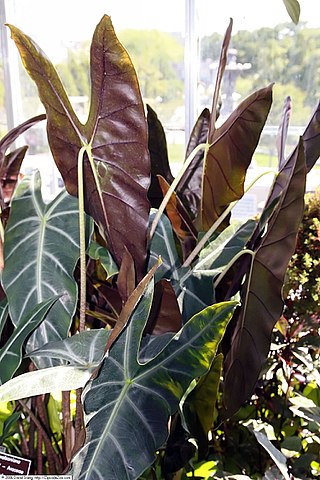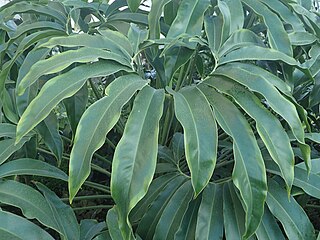
The Araceae are a family of monocotyledonous flowering plants in which flowers are borne on a type of inflorescence called a spadix. The spadix is usually accompanied by, and sometimes partially enclosed in, a spathe. Also known as the arum family, members are often colloquially known as aroids. This family of 140 genera and about 4,075 known species is most diverse in the New World tropics, although also distributed in the Old World tropics and northern temperate regions.

Amorphophallus is a large genus of some 200 tropical and subtropical tuberous herbaceous plants from the Arum family (Araceae), native to Asia, Africa, Australia and various oceanic islands. A few species are edible as "famine foods" after careful preparation to remove irritating chemicals. The genus includes the Titan arum of Indonesia, which has the largest inflorescence of any plant in the genus, and is also known as the 'corpse flower' for the pungent odour it produces during its flowering period, which can take up through seven years of growth before it occurs.

Anthurium is a genus of about 1,000 species of flowering plants, the largest genus of the arum family, Araceae. General common names include anthurium, tailflower, flamingo flower, and laceleaf.

Dracontium is a genus of flowering plants similar to those of Amorphophallus. Unlike Amorphophallus which is found in the Old World, this genus has a New World distribution and is native to South America, Central America, southern Mexico, and the West Indies.
Luis Sodiro (1836–1909) was a Jesuit priest and a field botanist who described a large number of species from the area around Quito, Ecuador in the early 20th century. He was perhaps the first person who collected in this region and he described at least 38 species from Esmeraldas, a region in Ecuador.
Carlephyton is a genus of four species in the family Araceae, all endemic to Madagascar.

Aroideae is a subfamily of flowering plants in the family Araceae. It is the largest subfamily in Araceae and consists of about 72 different genera, and 2,300 species. Many Aroideae have spiny pollen grains without a sporopollenin outer exine layer and lacking an aperture.

Urospatha is a genus of flowering plants in the family Araceae that consists of approximately 10 known species. They are found growing in South America and Central America in swamps, wet savannahs, and brackish water. The leaves of the species in this genus are upward pointing and sagittate (arrow-shaped). The inflorescences are quite unique; the spathe is mottled and elongated with a spiral twist at the end. The seeds are distributed by water and have a texture similar to cork that allows them to float. They also quickly germinate in water.
Bognera is a monotypic genus of flowering plants in the family Araceae. The single species that makes up the genus is Bognera recondita. The word recondita means "hidden" referring to the fact that the plant is only found in remote areas of Amazonian Brazil near the Peruvian border. The species was discovered in the late 1970s and was originally placed in the genus Ulearum, as Ulearum reconditumMadison, Aroideana 3: 101 (1980).

Montrichardia is a genus of flowering plants in the family Araceae. It contains two species, Montrichardia arborescens and Montrichardia linifera, and one extinct species Montrichardia aquatica. The genus is helophytic and distributed in tropical America. The extinct species M. aquatica is known from fossils found in a Neotropical rainforest environment preserved in the Paleocene Cerrejón Formation of Colombia. Living Montrichardia species have a diploid chromosome number of 2n=48.
Chlorospatha is a genus of flowering plants in the family Araceae. Chlorospatha can be found from Costa Rica, Panama, Colombia, Ecuador, and Peru.

Ulearum sagittatum is a species in the family Araceae. It is endemic to western Brazil and Peru, where it grows on the forest floor from small rhizomes. Its binomial name refers to the sagittate, meaning arrowhead-shaped, form of its leaves.

Ulearum is a genus of flowering plants in the family Araceae. It contains two known species, both native to South America. Ulearum is similar to Callopsis, but Callopsis is found only in Africa and so its relation is uncertain.

Philodendron verrucosum is a species of flowering plant in the family Araceae. It is native to Costa Rica, Panama, Colombia, Ecuador and Peru, and is a hemiepiphyte climbing plant. This Philodendron is kept by houseplant collectors for its unique appearance, with foliage that has slightly wavy edges, white veins, and flushes of reddish hues, as well as hairy bristles along its stems.

Pothoideae is a subfamily of flowering plants in the family Araceae. The species in the subfamily are true aroids.

Thaumatophyllum xanadu is a perennial plant belonging to the arum family Araceae and the genus Thaumatophyllum, formerly classified under the Meconostigma subgenus of Philodendron. This plant is native to Brazil, but is widely cultivated as a landscape plant in tropical, subtropical and warm temperate climates.
Thomas Bernard Croat is an American botanist and plant collector, noteworthy as one of botanical history's "most prolific plant collectors". He has collected and described numerous species of plants, particularly in the family Araceae, in his career at the Missouri Botanical Garden.

Alocasia longiloba is a species of flowering plant in the family Araceae. It is the namesake of a species complex. The complex has a widespread distribution; Guangdong, Hainan, and southern Yunnan in China, mainland Southeast Asia, and western and central Malesia.

Thaumatophyllum spruceanum is a neotropical hemiepiphytic or scrambling plant in the genus Thaumatophyllum, in the family Araceae. It is native to northern South America.












